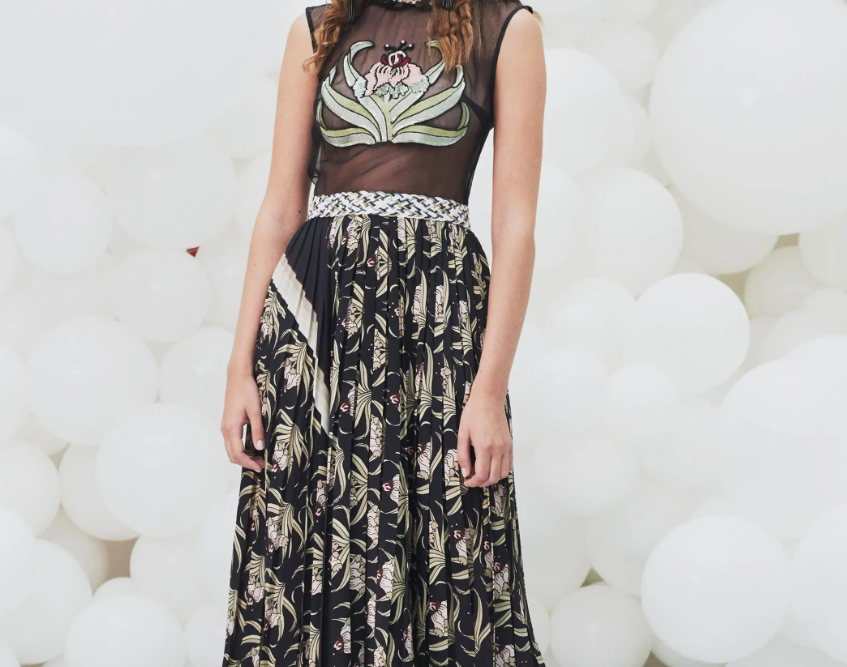
For centuries, Shakespeare is still showing us one thing or two about how to live and dress.
Shakespeare is very popular among designers these days. In fact, this Autumn/Winter 2019 collection has Shakespearean touches all over it. Following the debut of designer Riccardo Tisci's Burberry spring/Summer collection, which referenced Shakespeare in both clothes and bags, his Autumn/Winter 2019 show was called Tempest, drawing on the playwright's stories about islands, castaways and bizarre revenge.
In another location, designer David Koma is engrossed in two plays about gain and loss of power: Macbeth and King Lear. Inspired by Elizabethan clothing, the Georgian-born designer, in addition to numerous military details in his designs, also weaves in text images of butterflies and snakes.
Other designers may be less explicitly referencing Shakespeare, but we still find them looking to 16th century fashion. At that time, complex dress codes such as ruffled collars and corsets determined the dressing principles of different social classes. In the autumn/Winter 2019 show, many details have been updated.
We can see Juliet-style puffy sleeves in various variations at Khaite, Simone Rocha and Molly Goddard. The Elizabethan folds were more visible and extravagant than they are today. Designer Roksanda Ilincic featured multiple ruffles in pink, while designer label Osman featured a black and white spray design.In Milan, Gucci took a slight twist on Shakespeare's harlequin Pierrot with a sci-fi punk look of Romeo and Juliet Romeo and Juliet wearing disturbingly spiked masks.
Back in London, Matty Bovan's Folds and Corsets collection cites the trials of the wizards of Pendle as its main influence. Ten years after the opening of Macbeth - a play filled with contemporary fears of witchcraft and dangerous women - the famous trial of 1612 resulted in the hanging of 10 people, most of them women.
The focus on maligned Shakespearean women also inspired Hussein Chalayan's design, which the designer told Vogue was inspired by the fact that "throughout history, and even today, women have been accused of unjustified sexual behavior in public."
His Autumn/Winter 2019 fashion collection is his 25th year at Chalayan and he "wanted to reference what prostitutes wore in Shakespeare's day ‧‧‧‧‧‧ to blend in with the modern wardrobe, exploring many elements to create a powerful body image".
And his result - full of soft dark leathers, corsets, loose cuts that contrast between corsets and slushy valances - he created a seductive collection that looked at both history and modernity.
Syrian-born designer Nabil Nayal has also been thinking about the fusion of the past and the modern. "Between historical technology and highly modern methods, there is a force created by friction," he says.
For Nayal, this influenced a series of Elizabethan clothes: the most famous of which was his elaborate Spring/Summer 19 fashion show at the British Library, inspired by Elizabeth I's speech at Tilbury.
"It was a time of spectacle and pageantry, a time of high drama in fashion, affected by the social, cultural and religious changes of the time," Nayal explained when asked what drew him to this period. It was also a time full of contradictions: the Reformation is an important point of reference in my work, and the simplicity of the English people speaks to me of their love for black and white. On the contrary, the Elizabethan period was also an opulent time to celebrate craftsmanship, and we see people dressed in silks, brocades, and floral fabrics embroidered with gold and silver threads in the portraits painted at the time. But my favorite is the linen smock and the baggy shirt, which also includes the wheel ruffle -- an iconic symbol of the era."
These designers are not the first to experiment with the social and craft interactions of Shakespeare's time. Valentino's Fall/Winter 2016 haute couture collection drew on Shakespeare and the romanticism of Italian drama, especially a long black gown with text embroidery.
Alexander McQueen's autumn/Winter 2003 show had a haunting Twelfth Night and Tempest-esque element, paired with cropped tops, ruffles and Tudor cuts. At the same time, Vivienne Westwood's Autumn/Winter 1997 runway show also paid homage to Elizabeth's silhouette, complete with a characteristic chest-compression bodywear.
Back in 1980, Yves Saint Laurent designed a gorgeous jeweled wedding dress that paid tribute to the playwright and referenced Hamlet and Lady Macbeth as part of his creative process.
Shakespeare, the son of a glove maker, was always interested in what stories clothes could tell and how they could change or disguise a person - especially in the industry he worked in, where clothes were an important part of the show.
His plays are full of disguises: women dressed like swaggering men; Rich people wear poor people's clothes; In a masked ball, two romantic young people from rival families are allowed to meet under special circumstances. In his works, the appearance of people is changed, free of the symbols of power, and as small as a glove is filled with strong emotions.
Chalayan's fashion show is similar to a theatrical event, describing the relationship between clothing and performance as a "coherence of mind, body and space". Looking at the sleeves, the ruffles and some of the selected poems, one is also drawn into a series of fascinating links between eras, designers, words and history and clothing, and a playwright from long ago who continues to provide new inspiration for modern life.

